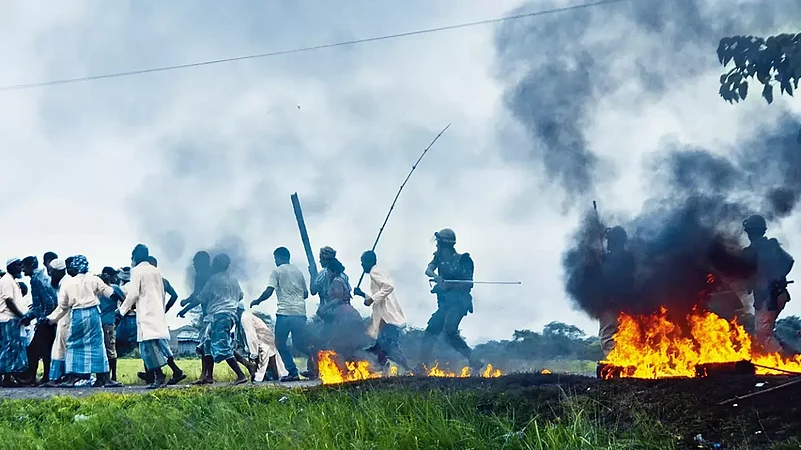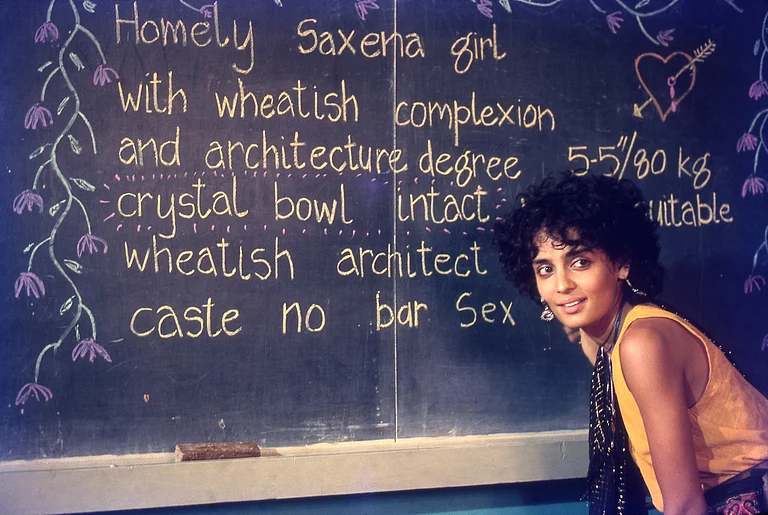The first time Amina Khatun, a woman in her 70s, lost her home, her homestead and the rice in her field, was 53 years ago when the river Brahmaputra took an unexpected turn during the monsoon and washed away thousands of hectares of land in Assam.
The second time she lost everything was during a freezing cold winter morning on December 19 when bulldozers ran over 47 houses in Haidubi forest area of Nagaon district. This time it was the Assam government which wanted Khatun and over 200 others to leave the land that they have been residing on for decades near the birthplace of Vaishnav saint Sankardeva.
According to the administration, Khatun and others have been encroaching upon the land that originally belongs to the Sattra, a monastic institution of the neo-Vaishnavite tradition started by Sankardeva. Apart from Haidubi, bulldozers went to Santijan Bazaar area, Lalungaon, Jamaibasti and Balisatra of Batadrava Mouza, under the Dhing revenue circle of the district. Within a day, it reduced over 300 houses to rubble in order to clear 1,200 bighas of land in four villages, in the presence of heavy security.
“I have been living here since 1970, after the devastating floods. Now I am again homeless. The only difference is that 43 years ago, I was 23 and I had the energy to figure out a place to live, set up a homestead and earn my living by working as a domestic labourer. But now I am too old and fragile and I no longer have the energy and the will to make a new home. I just want a small corner for the rest of my life to rest my head,” Khatun says.
In Haidubi, out of the 47 families rendered homeless, around 38 families are still residing near the eviction sites in makeshift huts made with tarpaulin sheets. These are the people who have nowhere to go. But the fear of the local police coming anytime and destroying their sheds in the cold of the winter is immense.
“We have children as young as a year old who are living in extreme cold under the tarpaulin sheets. They (the police) came this morning with the officer-in-charge and asked us to leave the site. Some of the policemen advised us to go and work outside the state. They fear that we might again start living here.” Barring two families, 45 other evicted families are of Bengali Muslim origin and earn their living as domestic helps and construction labourers. Many are engaged in cheap and unskilled labour in states in southern India.
“They suspect us to be Bangladeshis. But we have been living with due permission from the then Congress government in 1988. Look at these papers. We were given permission to settle here since we had no home,” said 68-year-old Habibur Rahman, another victim of eviction. He was holding a bunch of papers which were evidence of the then AGP government, led by chief minister Prafulla Mahanta having given permission to the families to settle in the forest land. Twenty metres from where Rahman was standing is an Anganwadi centre set up by the Social Welfare Department. According to the victims, among the destroyed structures were houses given by the previous governments to the homeless under different schemes.
Assam has always been at the helm of identity politics since it attained statehood in 1950, the same year a terrible earthquake hit it on Independence Day. The earthquake, among other factors, changed the course of the river Brahmaputra that flows through Tibet, Arunachal Pradesh and Assam. One of the highest intensity earthquakes in the region, it created havoc in the plains of Assam, raising the river beds and leaving many areas prone to flood and erosion. It led to the birth of a migratory community within the state which used to reside on the sandbars. The multiple floods that the state started facing after 1950, compelled them to shift from one place to another every couple of years when the river gulped down their chars (sandbars). This community, of Bengali-Muslim origin, is now at the centre of a vicious Hindu nationalist identity and vote bank politics in Assam.
The 15-year-long Congress government in the state had a significant vote bank among this demographic. In 2016, when the BJP started campaigning in the state, national and state leaders, rather than building the poor developmental record of the Congress government, chose to play identity politics and made the polls a straight fight of the ‘indigenous’ against the so-called ‘outsiders’.
BJP’s national leaders accused the Tarun Gogoi government of allowing ‘infiltrators’ to change the demography of the state. The pro-Hindu and anti-minority subtext is not hidden, in keeping with what Silchar-based anti-NRC activist Riya Ray calls “the historically jingoistic and anti-immigrant sentiment in Assam, ”
In fact, current Chief Minister, Himanta Biswa Sarma termed the polls the ‘Last Battle of Saraighat’—an infamous war fought in 1671
between the Ahoms and Mughals in Saraighat, near Guwahati. The BJP, for the first time, won 86 out of the 120 assembly seats in Assam, invoking the long unresolved issue of illegal migration in Assam, striking an alliance with regional party, the Asom Gana Parishad (AGP), whose leaders led the Assam agitation (1979-85). Assam became the first northeastern state that went to the BJP, riding on the sentiments of jaati (caste) maati (land) and bheti (hearth or house). Evictions are part of the poll promises of the BJP to make Assam ‘Bangladeshi-mukt’ (free), though, as Ray points out, referring to the Dolu Tea Estate eviction (to build an airport), “not just the BJP but all parties and tea union leaders were game too. The latter case involved indigenous Assamese tea tribes.” Abdul Khaleque, Congress MP from Barpeta Constituent Assembly, also asks, “Where are the rehabilitations? The government is evicting people without giving them a place to stay.” Crucially, he adds, “According to the Supreme Court guidelines, the administration cannot use bulldozers to evict people. This rule was flouted multiple times by the Assam government.”
According to the government’s data, over 4,400 families, mostly Muslims of Bengali origin, have been evicted from their homes since May 2021. However, the evictions face little or no resistance these days, after incidents of police opening fire on resisting residents led to the death of four civilians in two separate cases. “The evictions are vindictive as they are targeted at a particular community. This is a
violation of the Indian constitution. And we are opposed to this,” adds Khaleque.
In the second week of January, when the state was preparing to celebrate Magh Bihu, in another district of North Lakhimpur, around 500 families living inside the 46 sq km Pabha Reserve Forest were evicted in a span of three days. On Jan 14, sharing a video of several bulldozers and policemen going inside the forest, Sarma tweeted, “Our commitment to preserve our natural resources is sacrosanct. Happy to share that after 5 days of eviction exercise, 4,163 ha (32000 bigha) of Pabha Reserve Forest freed from encroachers. Total area in Pabha Reserve is 4625.85 ha.”
Anarul Islam, a local and leader of the All Assam Minority Students Union (AAMSU) , an organisation fighting for minority rights in the state, has alleged that within the eviction site, though Muslims and local tribal communities were living there, 95 percent of the houses bulldozed by the administration were those of Muslims. “These families had been living in the forest for more than five decades and these lands were barren lands. Now the administration has given a site to these people in Mohghuli-Borgula area of Naoboicha constituency to stay temporarily. But other than a few tubewells, no rehabilitation in terms of temporary houses nor have rations been provided to the 95 families living in the temporary camps which too were constructed by these evicted people,” he says.
(This appeared in the print edition as "Homeland Insecurities")


























